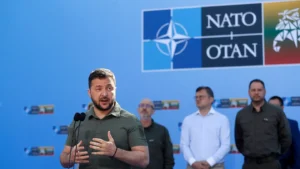NATO leaders have made a significant commitment to Ukraine’s future, with NATO’s Aid Pledge: Ukraine’s Path to Membership taking center stage at the recent summit in Washington, DC. This pledge, amounting to at least $43 billion in military aid within the next year, marks a crucial step in bolstering Ukraine’s defenses against Russian aggression. NATO’s Aid Pledge: Ukraine’s Path to Membership also formally declares Kyiv on an “irreversible path” to joining the Western military alliance. The summit’s final communique outlines not only the financial commitment but also specific military support, including the provision of F-16 fighter jets to Ukrainian pilots by this summer. This move, announced jointly by the United States, Netherlands, and Denmark, represents a significant boost to Ukraine’s air capabilities. Additionally, the US plans to deploy longer-range missiles in Germany by 2026, a strategic decision aimed at countering what NATO allies perceive as Russia’s growing threat to Europe.

Ukrainian President Volodymyr Zelenskyy expressed his gratitude for NATO’s efforts, particularly in strengthening Ukraine’s air force. He stated that the new fighter jets “bring just and lasting peace closer, demonstrating that terror must fail. While NATO’s Aid Pledge: Ukraine’s Path to Membership provides substantial support, it stops short of immediate NATO membership for Ukraine. The alliance’s communique promises to continue supporting Kyiv “on its irreversible path to full Euro-Atlantic integration, including NATO membership,” but notes that an invitation would come “when Allies agree and conditions are met.”
NATO Secretary-General Jens Stoltenberg emphasized that Ukraine’s membership is not imminent but insisted it must happen after the war to prevent future Russian aggression. He clarified that the aid is not intended to prolong the conflict but to end it as quickly as possible. The summit also addressed other global concerns, including China’s role in the Ukraine conflict. NATO’s communique labeled China a “decisive enabler” of Russia’s war effort, marking the first time the alliance has collectively made such a statement.
As the 2024 US presidential election approaches, questions about the future of US support for NATO have arisen. Stoltenberg defended the alliance’s importance, noting that criticism from the US has been about allies not investing enough in NATO, a situation that has significantly improved since 2021. President Joe Biden, hosting the North Atlantic Council, stressed NATO’s strengthened position since he took office, citing increased military spending and the doubling of battle groups on NATO’s eastern flank. However, with less than four months until the US election, Biden’s political challenges have cast a shadow over the gathering.
The pledges made at the summit are vital for Ukraine’s short-term defense and long-term security. They represent a unified front against Russian aggression and a commitment to the principles of collective defense that underpin NATO. However, the implementation of these pledges and Ukraine’s eventual path to NATO membership will likely depend on various factors, including the outcome of the US election and the evolving situation on the ground in Ukraine.
As NATO continues to adapt to new global challenges, the alliance’s support for Ukraine remains a critical test of its resolve and effectiveness. The coming months and years will reveal whether NATO’s Aid Pledge: Ukraine’s Path to Membership will indeed lead to a more secure Ukraine and a stronger, more united NATO.
















